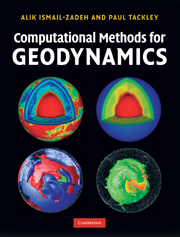Book contents
- Frontmatter
- Contents
- Foreword by Gerald Schubert
- Preface
- Acknowledgements
- 1 Basic concepts of computational geodynamics
- 2 Finite difference method
- 3 Finite volume method
- 4 Finite element method
- 5 Spectral methods
- 6 Numerical methods for solving linear algebraic equations
- 7 Numerical methods for solving ordinary and partial differential equations
- 8 Data assimilation methods
- 9 Parallel computing
- 10 Modelling of geodynamic problems
- Appendix A Definitions and relations from vector and matrix algebra
- Appendix B Spherical coordinates
- Appendix C Freely available geodynamic modelling codes
- References
- Author index
- Subject index
- Plates section
8 - Data assimilation methods
Published online by Cambridge University Press: 05 June 2012
- Frontmatter
- Contents
- Foreword by Gerald Schubert
- Preface
- Acknowledgements
- 1 Basic concepts of computational geodynamics
- 2 Finite difference method
- 3 Finite volume method
- 4 Finite element method
- 5 Spectral methods
- 6 Numerical methods for solving linear algebraic equations
- 7 Numerical methods for solving ordinary and partial differential equations
- 8 Data assimilation methods
- 9 Parallel computing
- 10 Modelling of geodynamic problems
- Appendix A Definitions and relations from vector and matrix algebra
- Appendix B Spherical coordinates
- Appendix C Freely available geodynamic modelling codes
- References
- Author index
- Subject index
- Plates section
Summary
Introduction
Many geodynamic problems can be described by mathematical models, i.e. by a set of partial differential equations and boundary and/or initial conditions defined in a specific domain. A mathematical model links the causal characteristics of a geodynamic process with its effects. The causal characteristics of the process include, for example, parameters of the initial and boundary conditions, coefficients of the differential equations, and geometrical parameters of a model domain. The aim of the directmathematical problem is to determine the relationship between the causes and effects of the geodynamic process and hence to find a solution to the mathematical problem for a given set of parameters and coefficients. An inverseproblem is the opposite of a direct problem. An inverse problem is considered when there is a lack of information on the causal characteristics (but information on the effects of the geodynamic process exists). Inverse problems can be subdivided into time-reverse or retrospective problems (e.g. to restore the development of a geodynamic process), coefficient problems (e.g. to determine the coefficients of the model equations and/or boundary conditions), geometrical problems (e.g. to determine the location of heat sources in a model domain or the geometry of the model boundary), and some others. In this chapter we will consider time-reverse (retrospective) problems in geodynamics.
- Type
- Chapter
- Information
- Computational Methods for Geodynamics , pp. 148 - 196Publisher: Cambridge University PressPrint publication year: 2010



